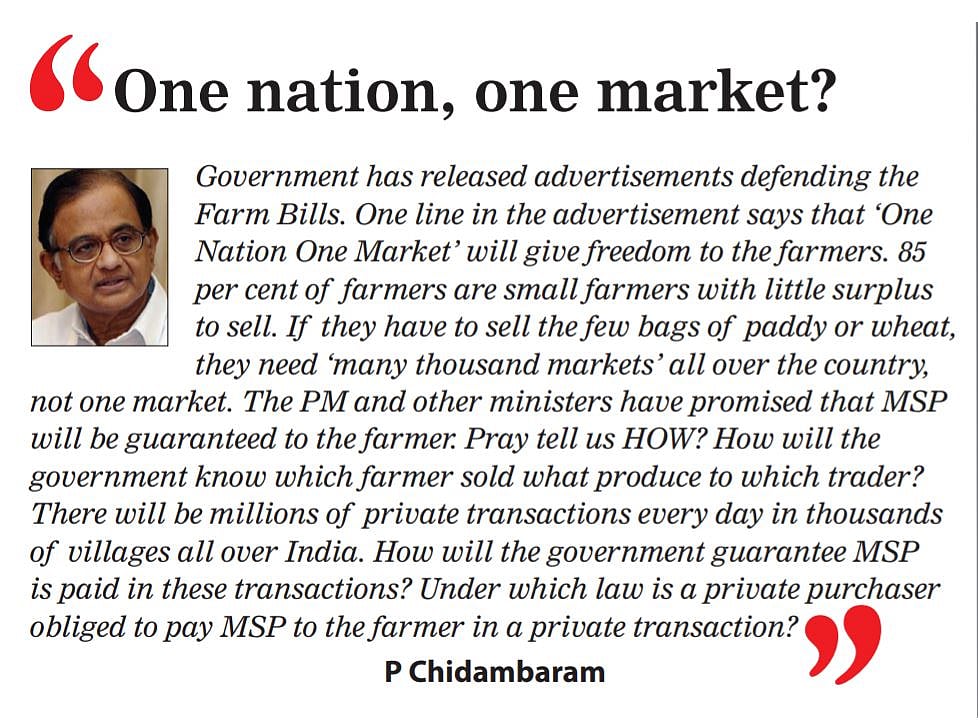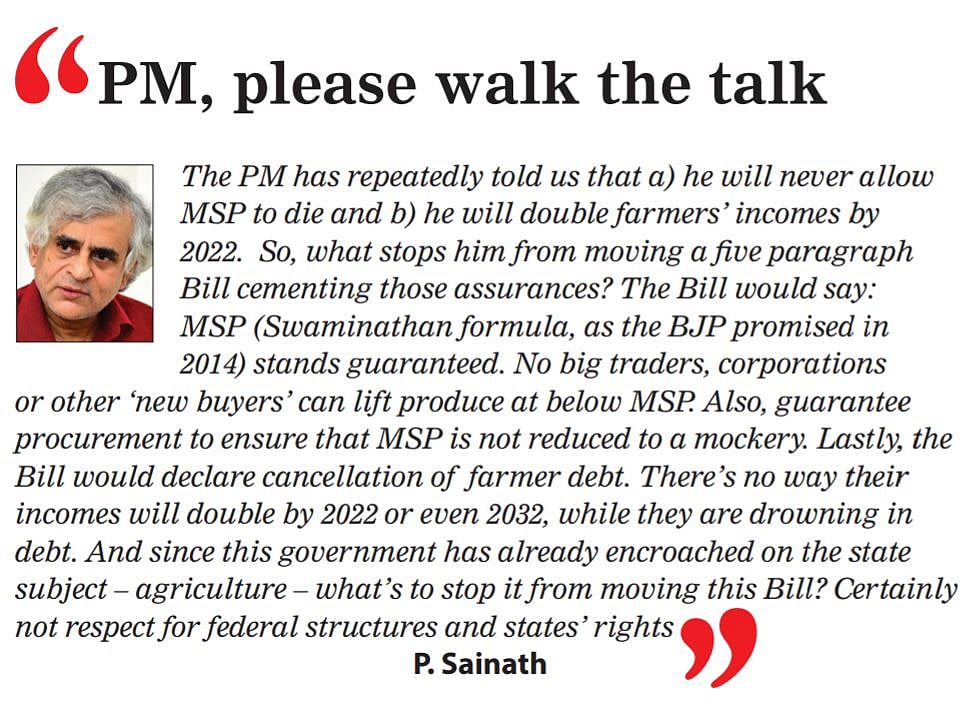Why are farmers protesting?
Although agriculture is a state subject, Centre sought to rush through amendments and usher in new laws without consultation with states. But farmers are primarily concerned with prices they get

Everything that the Government does these days is hailed as ‘historic’. But will the ‘historic’ farm reforms turn into historic blunders like the earlier Demonetisation, GST, and the lockdown?
The distrust for the Government is such that farmers are unwilling to accept the Prime minister’s assurances at face value. The Prime Minister has claimed that the opposition have been misleading the nation on farm bills; that his heart bleeds for farmers and his Government will never do away with the Minimum Support Price (MSP) regime. The fact is that the three ordinances, now approved by Parliament without much scrutiny, do not make any mention of doing away with the MSP or procurement of foodgrains by the Government.
But farmers, still waiting to see their income double by 2022 as promised by the BJP and Narendra Modi in 2014, are demanding MSP to be made into a legal right. It is fine for the PM to say that farmers are now free to sell their produce anywhere and at whatever price they like to anyone. But can the Government guarantee that prices will not tumble, that private corporate bodies and traders will not form a cartel and squeeze the farmers? And if the PM is so sincere about giving farmers higher prices, why not make it a law that prices for agriculture produce cannot be lower than MSP determined by the Government?
From vegetable growers to coffee planters, from apple growers to rice farmers, the experience has been that retailers, exporters and people who have added value to the produce by processing and marketing them, have made windfall profits. The farmers and the consumers have both been left in the lurch.

Food Policy expert Devinder Sharma had quoted a Reuters report that said, “Unlike producers of commodities such as oil and natural gas, coffee farmers have long suffered from being at the wrong end of the value chain — receiving only a small fraction of the retail price of their crop…” In India, Sharma calculated, for every cup of coffee sold at Rs 250 at coffee bars, coffee planters received just one Rupee.
The experience of farmers since June, when the ordinances were promulgated, have been far from happy. Produce not procured by the government have invariably been sold at prices lower than the MSP. So, what good are these laws if they are not assured of even the MSP? The following average rates prevailing on different dates during the last three months tend to confirm the farmers’ fears.
MSP for Moong for 2020-21: Rs 7,196 per quintal. Market price in MP: Rs 4,000 to Rs 4,500 per quintal. MSP for Soyabean: Rs 3,880 per quintal Market price in Hoshangabad: Rs 3,000 MSP for Maize: Rs 1,850 per quintal Market price in Punjab: Rs 8000 MSP for cotton: Rs 5,515-5,825/quintal Market Price in Punjab: 4,600/quintal.
That farmers get low prices is known. Vegetable growers and dairy farmers, those who are not organized like the AMUL cooperative, know it too well. The price of cauliflowers in eastern India, for example, has not changed in 40 years though input prices have increased. The growers still sell 100 cauliflowers for prices ranging from Rs 20 to Rs 30 to the wholesaler. The retail price of each cauliflower would, however, vary between Rs 30 and Rs 50.

Retailers and middlemen run away with huge margins while neither consumers nor producers get the benefit.
How will the new regime change that? Will Ambanis and Adanis, who are expanding and extending their agri-business, give farmers a fair deal?
When corporate entities were allowed into agri business and retailing, it was claimed that they would bring in capital and technology, set up cold storages and cold chains, improve quality and use refrigerated vans for transport etc. A win-win situation for everyone, it was then said. Those hopes have been belied. So, what is the guarantee that this time round, corporate bodies will deliver on the promises?
The three laws introduced by the Government, on paper at least, seem well intentioned. The Farmers’ Produce Trade and Commerce (Promotion and Facilitation) Bill, 2020 – allows farmers to bypass the Agricultural Produce Market Committee (APMC) and sell the produce directly to a big company, warehouses, cold storage chains, or even set up shop to sell directly to consumers.
The Farmers (Empowerment and Protection) Agreement on Price Assurance and Farm Services Bill, 2020 allows for contract farming, for a farmer to get into a contract with a buyer to cultivate specific products for a specific price. This ensures that farmers know the price they will get even before cultivation starts.
The Essential Commodities (Amendment) Bill, 2020 allows buyers to purchase and stock commodities without getting called a hoarder and being vulnerable to penal action.
The changes in law facilitates the entry of big retailers and exporters in the market. The Government would like to withdraw from the business of procuring foodgrains and eventually hand over the assets of Food Corporation of India (FCI) to these private corporates. While it makes sense from the Government’s point of view, the implications of such a move are by no means certain in the long run.
The corporate bodies, unlike the Government, will be interested in maximizing their profit. If this objective is achieved by hoarding, exporting or by not buying the produce, they will not hesitate to do so. While free market economics, which allows market forces to not only fix the price but also the output, might work in countries with small populations and a large export market, it could be disastrous in a poor, developing country like India. The impact the market uncertainties can have on the farmers’ choice to produce one crop and not the other can also be severe.
The difference made by private trade is sharply brought out by the following social media post by Mumbai based journalist Sujata Anandan. It is worth reproducing the post:
“For those who wonder why farmers are protesting - here's a live example from Kerala. A friend's uncle was ecstatic when the Modi govt abolished the coconut board, akin to the APMC. The Coconut Board, a government outfit, offered Rs 10 per coconut. After abolition of the Coconut Board, price offered by private traders was Rs 40 per coconut.”
“But the Coconut Board would bring their own men to scale up trees, cut the outer green shell of coconuts & transport them to the market. Now this man has to hire people to climb the trees, and since it is risky, pay for their insurance. He has to pay more for peeling the green skin and then transport the coconuts to the market and return. After meeting all the expenses, he gained Rupees four per coconut.”
The consumer was earlier paying Rs 20 to 40 per coconut. Now prices begin at Rs 50.
Now you know why the farmers are protesting.
Follow us on: Facebook, Twitter, Google News, Instagram
Join our official telegram channel (@nationalherald) and stay updated with the latest headlines
